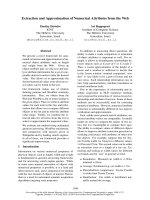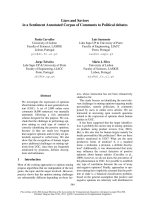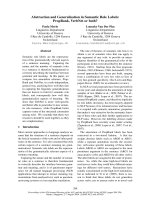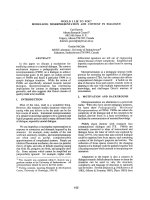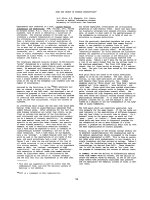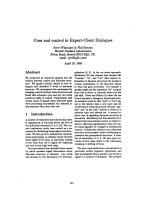Báo cáo khoa học: "Antithrombin and hypercoagulability in sepsis: insights from thrombelastograph" potx
Bạn đang xem bản rút gọn của tài liệu. Xem và tải ngay bản đầy đủ của tài liệu tại đây (32.78 KB, 2 trang )
Page 1 of 2
(page number not for citation purposes)
Available online />Abstract
Antithrombin (AT) has been used for over 25 years to successfully
treat disseminated intravascular coagulation (DIC). A four-day AT
therapy in patients with DIC in the KyberSept trial has been related
to a clear survival benefit in patients not receiving concomitant
heparin. Gonano and coworkers performed thrombelastography
(TEG) measurements in patients with severe sepsis and clearly
showed hypercoagulability, as defined by five TEG parameters,
compared to healthy controls. In the AT group they found a trend
towards normalization of TEG parameters after treatment, although
this did not reach statistical significance. This first clinical
evaluation of hypercoagulability during AT treatment could not
provide evidence for an attenuation of coagulopathy, an effect that
might be due to high inter-individual variability.
In a recent paper, Gonano and coworkers [1] reported the
potential failure of antithrombin (AT) therapy to modulate
hypercoagulability, as evident from TEG measurements. AT
constitutes the principal physiological inhibitor of thrombin
and of other serine proteases of the clotting cascade, and
has been shown to interfere with the clotting process at
various sites [2]. AT activity is decreased in patients with
trauma, shock and sepsis by virtue of its consumption during
complex formation with clotting factors, and by degradation
via granulocyte elastase [3]. The first application of AT in a
patient with septic shock complicated by disseminated
intravascular coagulation (DIC) was described in 1978 [4].
Following this report, many intensive care specialists have
also used this natural coagulation inhibitor over more than 25
years to treat coagulopathy in patients with sepsis
complicated by DIC. The KyberSept trial investigated the
effects of a four-day AT therapy in 2,314 patients with severe
sepsis [5]. In this study, AT treated patients did not benefit
overall in terms of 28-day and 90-day mortality. In a recent
subgroup analysis, however, concomitant heparin application
was characterized as the major reason for the failure of the
AT treatment; 28-day as well as 90-day mortality were
improved in patients not receiving concomitant heparin
during the treatment phase [6]. Given that AT was clearly
more effective in KyberSept patients with DIC than those
without it [7], the characterization of AT’s actions on
hypercoagulability in sepsis clearly seems to be interesting
and important.
In a recent issue of Critical Care, Gonano and co-workers [1]
analyzed hypercoagulability in a subset of patients in the
KyberSept trial by thrombelastography (TEG) and routine
coagulation tests. They presented data from 16 placebo and
17 AT treated patients receiving concomitant heparin. Septic
patients in both groups clearly showed hypercoagulability, as
defined by five TEG parameters, when compared to normal
values. This information may be important given that the
severity of coagulatory disorders has been clearly correlated
with decreased survival, and because the International
Society of Thrombosis and Hemostasis score is a perfect
predictor of mortality [8]. Characterization of septic
coagulopathy by TEG has not been published thus far, and
the clinical relevance of these measurements has to be
determined in further studies.
Coagulatory parameters during high dose AT
supplementation have already been extensively characterized
in four-day studies [9] as well as during long-term (14-day)
treatment [10]. All studies clearly show a reduction in the
severity of DIC with the administration of AT when measured
with standard coagulation tests [9-11]. Thus far, no studies
looking at TEG measurements in this scenario have been
performed.
At least for us, it remains unclear from the given data whether
AT therapy really is unable to influence hypercoagulability, as
Commentary
Antithrombin and hypercoagulability in sepsis: insights from
thrombelastography?
Johannes N Hoffmann and Kerstin Schick
Department of Surgery, University of Munich, Großhadern, Marchioninistr., 81377 München, Germany
Corresponding author: Johannes N Hoffmann,
Published: 23 February 2007 Critical Care 2007, 11:115 (doi:10.1186/cc5156)
This article is online at />© 2007 BioMed Central Ltd
See related research by Gonano et al., />AT = antithrombin; DIC = disseminated intravascular coagulation; TEG = thrombelastography.
Page 2 of 2
(page number not for citation purposes)
Critical Care Vol 11 No 1 Hoffmann and Schick
was indicated in the study by Gonano and colleagues [1] by
TEG measurements with high inter-individual variability.
Despite this variability, in this pilot trial with 33 patients, the
group treated with AT also showed an attenuation of
hypercoagulability after an intravenous bolus of AT, and no
differences in the later time course when compared to
controls without AT. It could be speculated that this AT effect
will gain statistical significance in a better powered trial. One
problem with the KyberSept trial design in terms of efficacy in
hypercoagulability could be the treatment period of only four
days. In other studies, however, a four day treatment period
has allowed AT to become effective with regard to DIC [10].
There is some evidence from a small clinical pilot trial that
prolonged AT supplementation with adjusted activity (>120%
activity) can modify coagulatory parameters [10]. However,
the validity of this concept of prolonged, dose-adapted AT
support has not been further established by the literature.
From the given data it seems to be debatable whether AT
action in septic patients is really dependent on its effect on
hypercoagulability. Other key mechanisms could include the
microhemodynamic and cellular actions of AT during
endotoxemia [11]; AT was shown to effectively prevent
endotoxin-induced leukocyte adhesion to the endothelium
and to improve capillary performance, both of which are
known to be crucial during the development of multiple organ
dysfunction in sepsis.
Since TEG has been shown to be a highly sensitive assay for
hypercoagulability, TEG measurements may indicate distinct
changes in coagulation in septic patients that can not be
measured by standard tests. After correlation of these
laboratory findings with clinical data, TEG may become
important for future trials investigating pharmacological
anticoagulation strategies in patients with severe sepsis.
Competing interests
JNH has received honoraria for oral presentations from
Biotest, CSL-Behring, Fresenius and Octapharma. JNH has a
scientific cooperation sponsored by CSL-Behring.
References
1. Gonano C, Sitzwohl C, Meitner E, Weinstabl C, Kettner SC:
Four-day antithrombin therapy does not seem to attenuate
hypercoagulability in patients suffering from sepsis. Crit Care
2006, 10:R160.
2. Bone RC: Modulators of coagulation. A critical appraisal of
their role in sepsis. Arch Intern Med 1992, 152:1381-1389.
3. Cohen JR, Sarfati I, Birnbaum E, Benacquista T, Wise L: The
inactivation of antithrombin III by serum elastase in patients
with surgical infections. Am Surg 1990, 56:665-667.
4. Blatt PM, White GC 2nd, Goldsmith JC, Roberts HR: Antithrom-
bin-III transfusion in disseminated intravascular coagulation.
Lancet 1978, 1:1212.
5. Warren BL, Eid A, Singer P, Pillay SS, Carl P, Novak I, Chalupa P,
Atherstone A, Penzes I, Kübler A, et al.: High-dose antithrombin
III in severe sepsis: a randomized controlled trial. JAMA 2001,
286:1869-1878.
6. Hoffmann JN, Wiedermann CJ, Juers M, Ostermann H, Kienast J,
Briegel J, Strauss R, Warren BL, Opal SM: Benefit/risk profile
of high-dosed antithrombin in patients with severe sepsis
treated with and without concomitant heparin. Thromb
Hemost 2006, 95:850-856
7. Kienast J, Juers M, Wiedermann CJ, Hoffmann JN, Ostermann H,
Strauss R, Keinecke HO, Warren BL, Opal SM, Kybersept Investi-
gators: Treatment effects of high-dose antithrombin without
concomitant heparin in patients with severe sepsis with or
without disseminated intravascular coagulation. J Thromb
Haemost 2006, 4:90.
8. Angstwurm MW, Dempfle CE, Spannagl M: New disseminated
intravascular coagulation score: a useful tool to predict mor-
tality in comparison with Acute Physiology and Chronic
Health Evaluation II and Logistic Organ Dysfunction scores.
Crit Care Med 2006, 34:314-20; quiz 328.
9. Fourrier F, Chopin C, Huart JJ, Runge I, Caron C, Goudemand J:
Double-blind, placebo-controlled trial of antithrombin III con-
centrates in septic shock with disseminated intravascular
coagulation. Chest 1993, 104:882-888.
10. Hoffmann JN, Muhlbayer D, Jochum M, Inthorn D: Effect of long-
term and high-dose antithrombin supplementation on coagu-
lation and fibrinolysis in patients with severe sepsis. Crit Care
Med 2004, 32:1851-1859.
11. Hoffmann JN, Vollmar B, Laschke MW, Fertmann JM, Jauch KW,
Menger MD: Microcirculatory alterations in ischemia reperfu-
sion injury and sepsis: effects of activated protein C and
thrombin inhibition. Crit Care 2005, 9(Suppl 4):S33-37.



